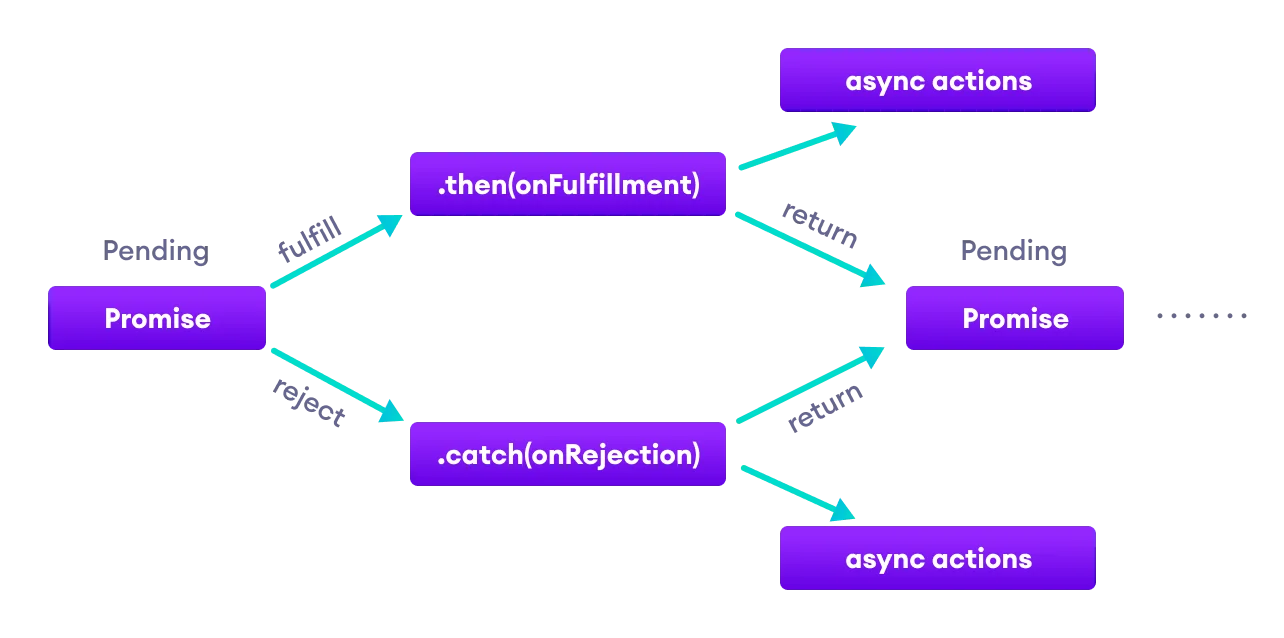JavaScript is a versatile language that handles asynchronous operations efficiently using promises. One of the most powerful features of promises is promise chaining, which allows you to link multiple asynchronous tasks together in a sequence. This article will show what promise chaining is, why it’s useful, and how to implement it with code to clarify things.
What is a Promise in JavaScript?
A Promise is basically an object which represents the completion (or failure) of an asynchronous operation along with its result.
A promise may have one of three states.
- Pending
- Fulfilled
- Rejected
A promise starts in a pending state. That means the process is not complete. If the operation is successful, the process ends in a fulfilled state. And, if an error occurs, the process ends in a rejected state. Here’s a basic example of a promise:
let promise = new Promise(function(resolve, reject) {
// Asynchronous operation
let success = true; // or false based on some condition
if (success) {
resolve("Operation was successful!");
} else {
reject("Operation failed");
}
});
promise.then(function(message) {
console.log(message);
}).catch(function(error) {
console.log(error);
});What is Promise Chaining in JavaScript?
Promise chaining is a technique for sequentially handling asynchronous operations using .then() and .catch methods.

It allows you to create a chain of promises, where the result of one promise, where the result of one promise is posted to the next as input. This helps avoid callback hell, a situation where callback becomes difficult to read and manage.
Promise chaining involves linking multiple .then() methods to handle sequential asynchronous operations. Each .then() method returns a new promise, allowing another .then() to be chained onto it. This creates a sequence of promises that execute one after another.
function firstTask() {
return new Promise((resolve, reject) => {
setTimeout(() => {
console.log('First Task Complete');
resolve('Task 1 Result');
}, 1000);
});
}
function secondTask(resultFromFirst) {
return new Promise((resolve, reject) => {
setTimeout(() => {
console.log('Second Task Complete');
resolve(`Task 2 Result derived from: ${resultFromFirst}`);
}, 1000);
});
}
firstTask()
.then(result => secondTask(result))
.then(finalResult => {
console.log('All tasks complete:', finalResult);
})
.catch(error => {
console.error('An error occurred:', error);
});In the example above, firstTask and secondTask are two functions that return promises. The result of the first task is passed to the second task through the chaining mechanism.
Advantages of Promise Chaining
- Readability: Makes code easier to read and maintain.
- Error Handling: A single
.catch()at the end can handle errors from any step in the chain. - Sequencing: Ensures that asynchronous operations occur in a specific order.
Error Handling in Promise Chaining
One significant advantage of promise chaining is centralized error handling. If any promise in the chain fails, control passes to the nearest .catch().
firstTask()
.then(result => {
throw new Error('Something went wrong');
return secondTask(result);
})
.then(finalResult => {
console.log('This will not be logged');
})
.catch(error => {
console.error('Caught an error:', error.message);
});Real-World Example: Fetching Data
Here’s a practical example where we fetch data from an API and process it in a sequence:
fetch('https://api.example.com/data')
.then(response => {
if (!response.ok) {
throw new Error('Network response was not ok');
}
return response.json();
})
.then(data => {
console.log('Fetched data:', data);
return fetch(`https://api.example.com/details/${data.id}`);
})
.then(response => {
if (!response.ok) {
throw new Error('Network response was not ok');
}
return response.json();
})
.then(details => {
console.log('Fetched details:', details);
})
.catch(error => {
console.error('There has been a problem with your fetch operation:', error);
});In this example, each .then() processes the result of the previous asynchronous operation, making the flow of data clear and manageable.
Conclusion
Promise chaining in JavaScript provides a robust way to handle asynchronous operations sequentially. By chaining promises together, you can perform complex sequences of operations with ease and maintain readability in your code. Remember to always handle errors appropriately to ensure your application remains robust.

